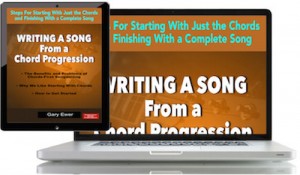When you conjure up the first musical bits that will become your next song, those bits are likely going to become part of your song’s chorus. That’s because it’s most likely that you’ll find it easy to think up something like a hook than something like a verse or a bridge.
And hooks are going to be the backbone of your chorus, at least most of the time. So I think it’s safe to say that choruses will usually come together easier than verses. With a chorus you get the following typical characteristics:
- Short, repetitive melodic ideas.
- A relatively short, tonally strong chord progression.
- A lyric that features a good deal of repeated words and phrases.
 Gary’s just released “Writing a Song From a Chord Progression”, a 35-page manual to help songwriters who like starting the songwriting process with a chord progression.
Gary’s just released “Writing a Song From a Chord Progression”, a 35-page manual to help songwriters who like starting the songwriting process with a chord progression.
It’s included in “The Essential Secrets of Songwriting 10-eBook Deluxe Bundle”.
Starting with the chorus means that you’ll get quite excited about this new song, and it gives you the impression that the rest of the song will come together quickly. But more often than not, a verse will take more time, and require more experimenting before it sounds right. That’s where discouragement sets in, and you’re left with the feeling that you can’t get beyond your chorus.
Does that describe where you are with your latest attempt to write a song? If so, here are three useful tips to consider that will help if you’re stuck, and can’t get beyond the chorus.
- Take your chorus chord progression, and reorder it to make your verse progression. In other words, if you’re using this as your chorus progression: Am Dm Am G, it may work just fine to take it and put the chords in a different order, like this: G Am Dm G. Optionally, you might try to add a chord to the verse progression, maybe something like this: G Am Dm C. This helps you come up with something similar to, but not identical to, your chorus progression.
- Improvise melodies by staying mostly lower in pitch. Verse melodies are usually lower than chorus melodies, so if you’re trying to find that elusive verse melody, start by making sure you stay below the range of your chorus melody.
- Write a short story to find your verse lyric. Make the assumption that your chorus lyric is what the song’s all about. Then, to write an effective verse lyric, you need a backing story — something that leads naturally to your chorus lyric. So write a short story that describes how you got to the situation you’re singing about in the chorus. Once you have the story, create a list of words and phrases that might make their way into your verse. You’re trying to create a verse that leads naturally to your chorus.
Having a chorus come together quickly makes you think that there’s something wrong if the verse doesn’t immediately happen. But in fact, many good songwriters spend a lot of time on the verse, much more time than they spend on the chorus, and that’s normal.
So take the time you need to get your chorus working, and then use that chorus to help you generate ideas for your verse. Don’t put a timetable on it — it may come together quickly, or it may take days or even weeks.
How you know your verse is finally working is that everything points to the chorus as being a musical and emotional release for your verse.
 Written by Gary Ewer. Follow Gary on Twitter
Written by Gary Ewer. Follow Gary on Twitter
“The Essential Secrets of Songwriting” 10-eBook Deluxe Bundle always comes with a FREE GIFT! Read more.











